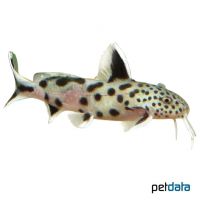Dwarf Lake Synodontis (Synodontis lucipinnis)
| Dwarf Lake Synodontis Synodontis lucipinnis | |
|---|---|
| Name | Dwarf Lake Synodontis |
| Name Lat. | Synodontis lucipinnis |
| Family | Upside-down Catfishes |
| Family lat. | Mochokidae |
| Order | Catfishes |
| Order lat. | Siluriformes |
| Origin | Lake Tanganyika |
| Habitat | Rocky intermediate zone |
| Diet | Omnivore |
| pH | 7.5-9.0 |
| Behavior | Nocturnal, peaceful |
| Keeping | Group |
| Care Level | Moderate |
| Reproduction | Egg scatterer |
| Breeding | Difficult |
| Life Span | 10-15 years |
| Protection | No |
| Metric Units | |
| Size | 8-10 cm |
| Temperature | 24-28 °C |
| Hardness | 15-18 °dH |
| Aquarium | 120 l |
| US Units | |
| Size | 3"-4" |
| Temperature | 75-82 °F |
| Hardness | 267-320 ppm |
| Aquarium | 30 gal |
Distribution and habitat
The crepuscular and nocturnal dwarf featherbeard catfishes occur exclusively (endemically) in the southern part of Lake Tanganyika in Zambia. They live in the scree zone with sandy bottoms and mostly stay in stone caves during the day.
Maintenance
The aquarium should have a good border planting with many hiding places between stone structures (e.g. perforated rock) and roots as well as offer sufficient swimming space. A dark sand substrate, shaded light (floating plants) and a weak current is ideal.
No ammonia, ammonium and nitrite should be detectable, the nitrate value should not exceed 100 mg/l. To ensure the water quality and oxygen content, a filter and heater adapted to the aquarium size is required, as well as lighting for the species-appropriate day-night rhythm of the animals.
Diet
They are easy to feed and will accept any type of live or frozen food, such as daphnia, cyclops, mysis, artemia and black mosquito larvae, as well as sinking dry catfish food (granules, pellets, tablets). In addition, they need regular vegetable food, such as crushed peas, cucumber slices, mashed leafy and wild vegetables or dry food with high vegetable content (spirulina, kelp)
A regular and varied diet promotes health and prevents deficiency symptoms. Only feed as much as will be eaten in a few minutes.
Behaviour and compatibility
These peaceful fish should be kept in a group of at least 5 animals. In too small, tanks, intraspecific incompatibilities can occur with adult animals. A group should only be kept in a larger and richly structured tank. They can be well socialized with other fish, such as cichlids, barbs or catfish.
Basically, only compatible fish species with similar demands on water condition and water temperature should be socialized.
Sex dimorphism
The males are more slender than the females. With some experience, the sexes can be determined by the shape of the genital papilla, which is pointed in the male and round in the female.
Reproduction and breeding
The dwarf featherbeard catfish are free spawners. After mating (T-position), the females spawn several hundred eggs over the sandy bottom. The parents do not engage in brood care. After about 24 hours the larvae hatch and after another 2-3 days the very small fry swim free
Fry must be fed several times a day with special rearing food (infusoria, dust food, Artemia nauplii). In community tanks breeding is hardly possible, because the spawn is easy prey.
Important
The fish change color several times until they are fully grown.
Mostly they stay in caves or under roots during the day, often hiding with the belly upwards. In shaded aquariums, however, they are also active during the day and come out of hiding especially for feeding.
When catching them, use nets with as fine a mesh as possible to prevent the hard rays of the pectoral and dorsal fins from becoming entangled, which can cause painful stinging injuries when touched.
The well-being of the fish should be checked regularly. Temperature should be checked daily, pH, hardness and nitrate levels at least every 14 days. Regular partial water changes are recommended, even when contaminant levels have not yet reached the upper limit. Sudden changes in water quality should be avoided. Newly introduced fish must be accustomed slowly to the water in the aquarium.
Further literature can be found in your pet store.
References
Text: Werner Winter; Image: petdata
Source: BMELV (1998): Tierschutzgutachten - Haltung von Zierfischen (Süßwasser); ENGELMANN (2005): Zootierhaltung - Tiere in menschlicher Obhut: Fische, Verlag Harri Deutsch
- Gemäß § 21 Abs. 5 Tierschutzgesetz idgF
